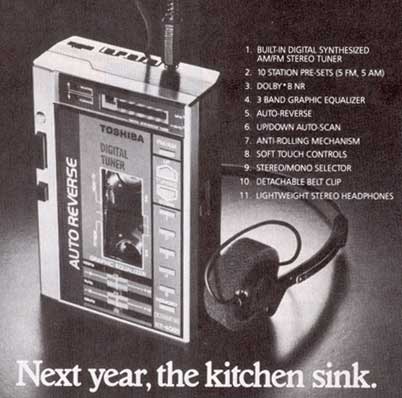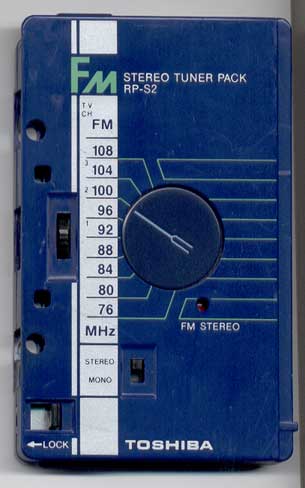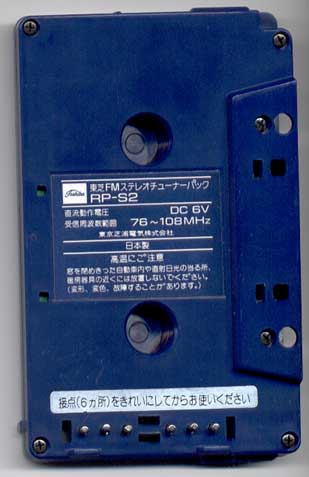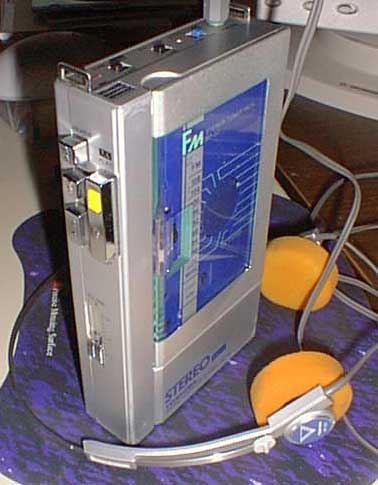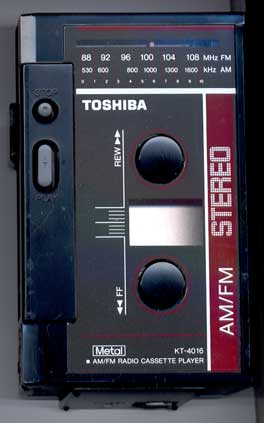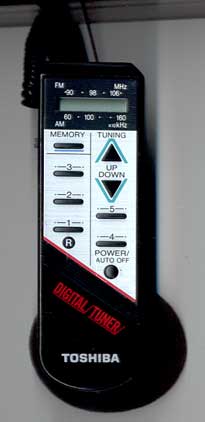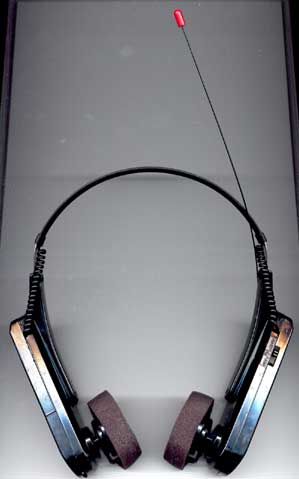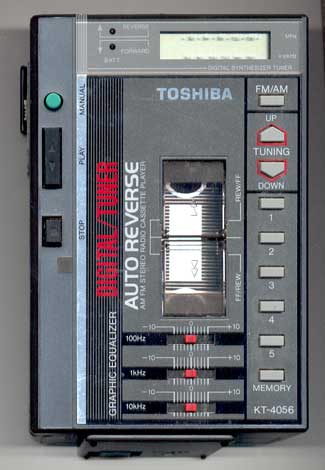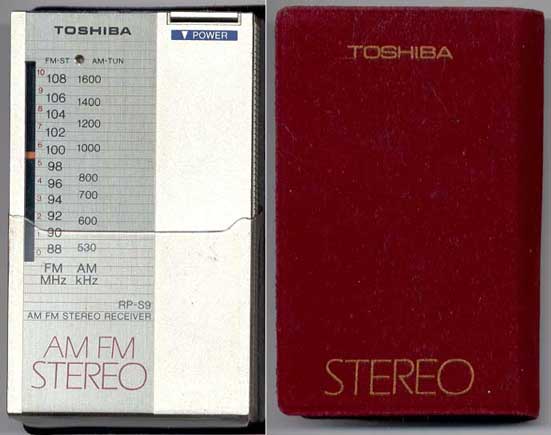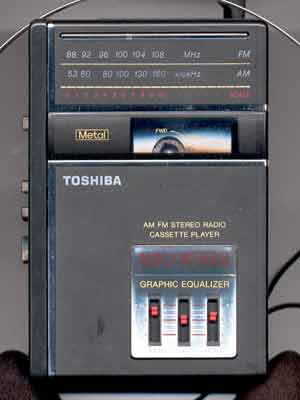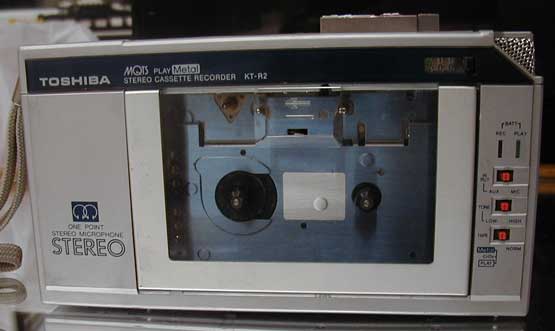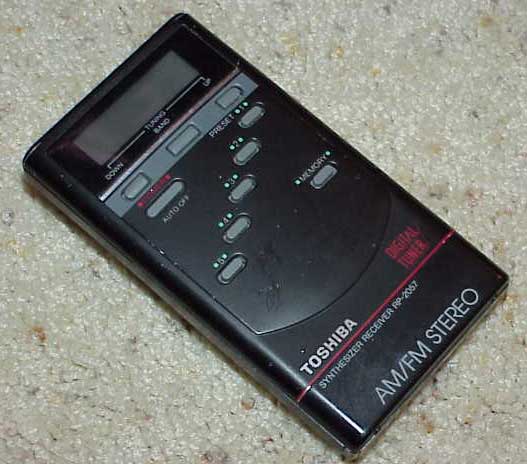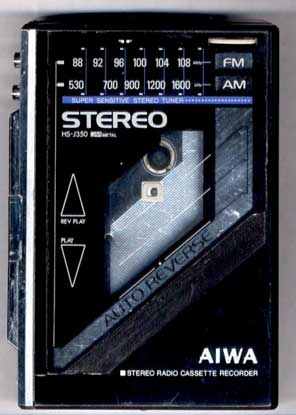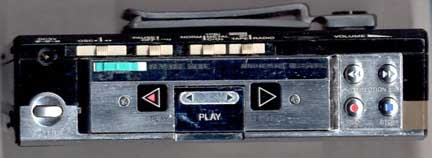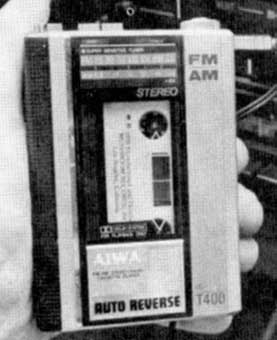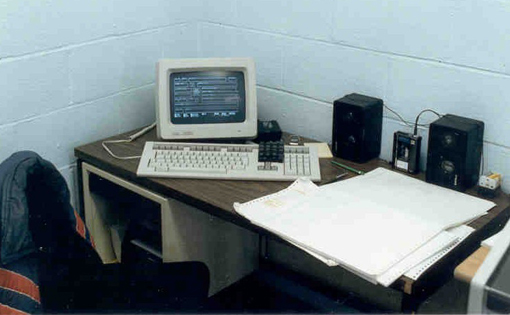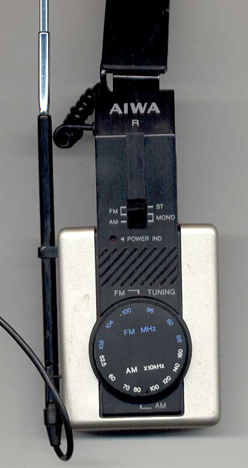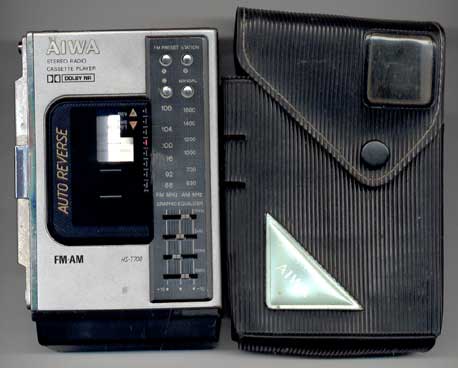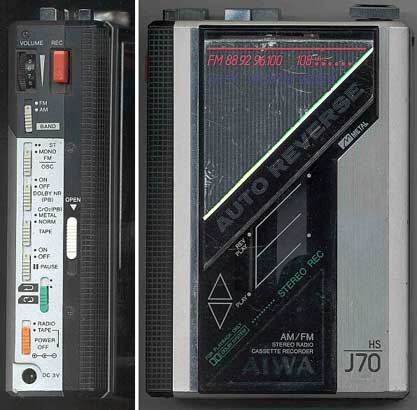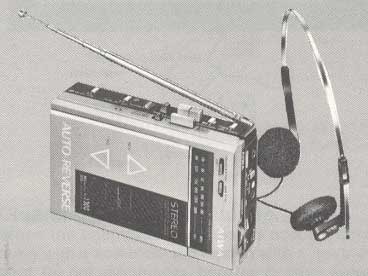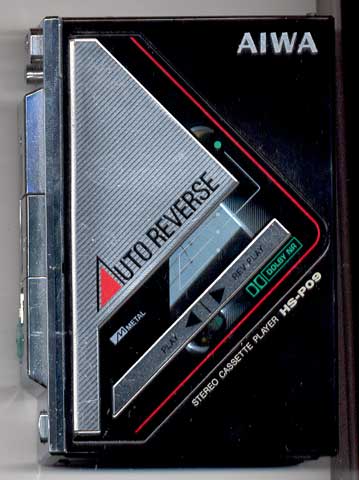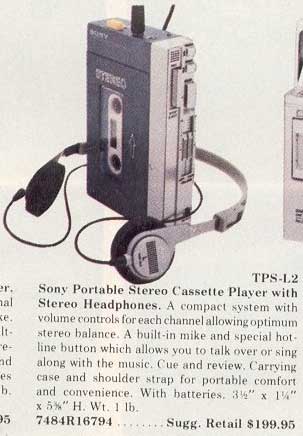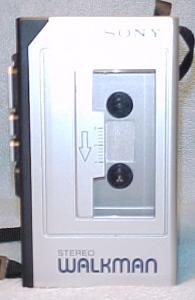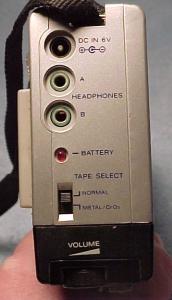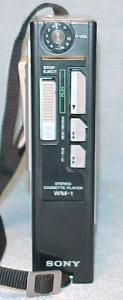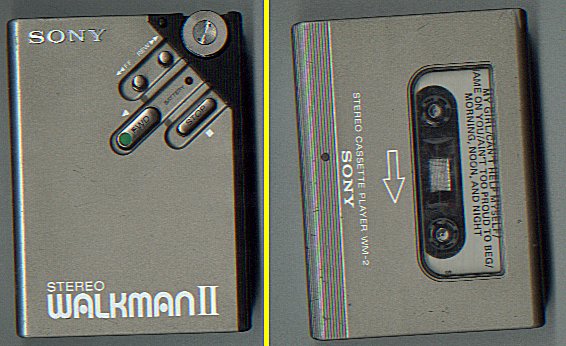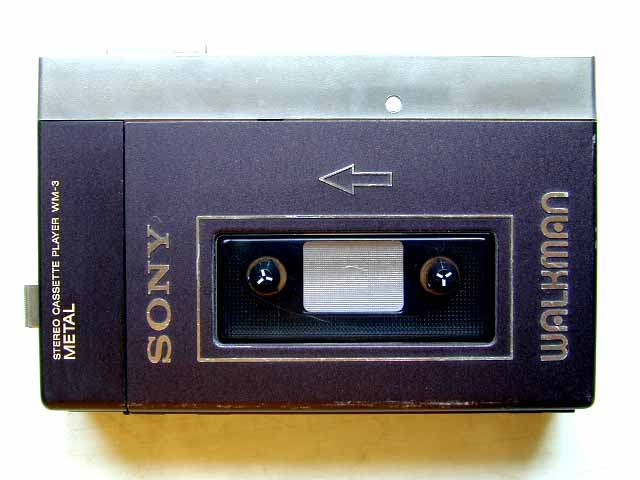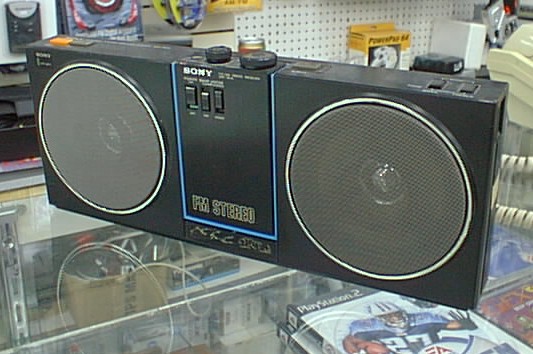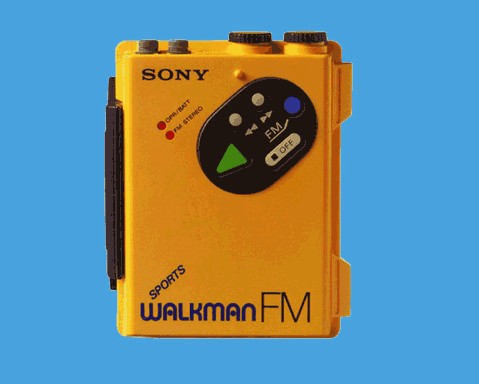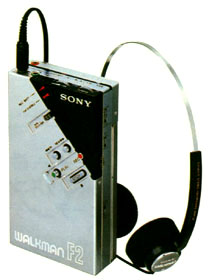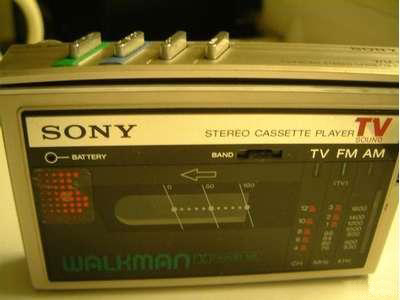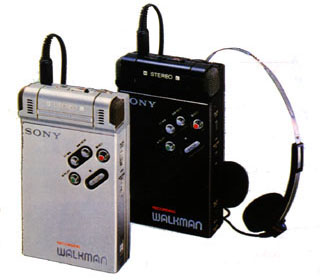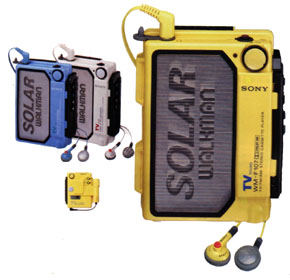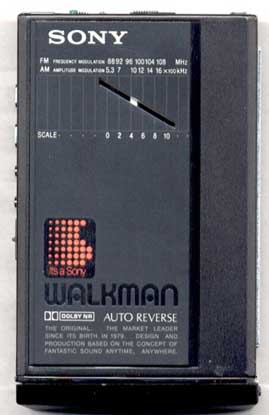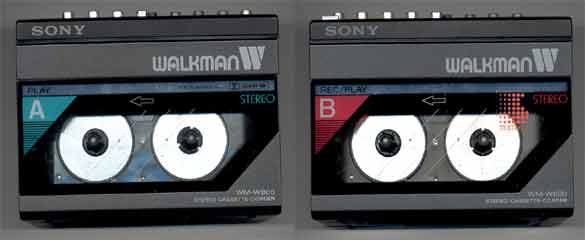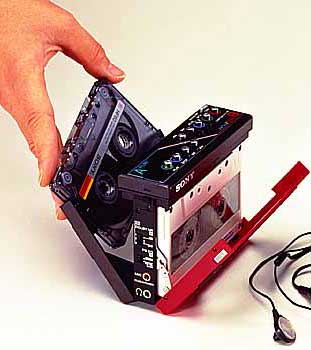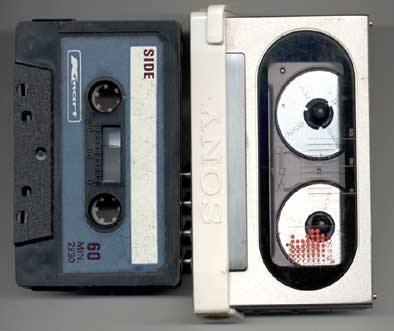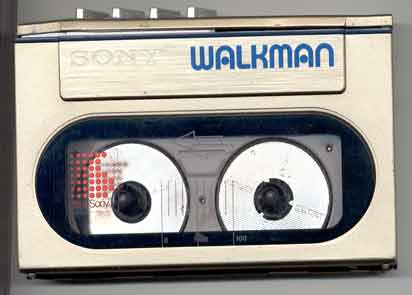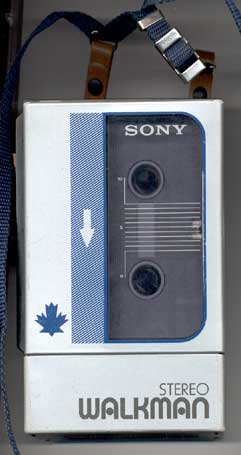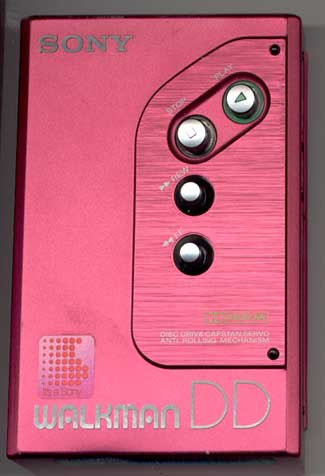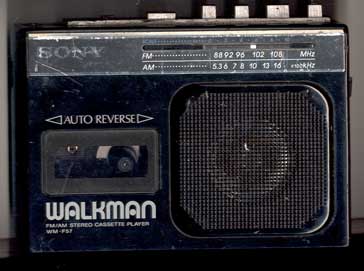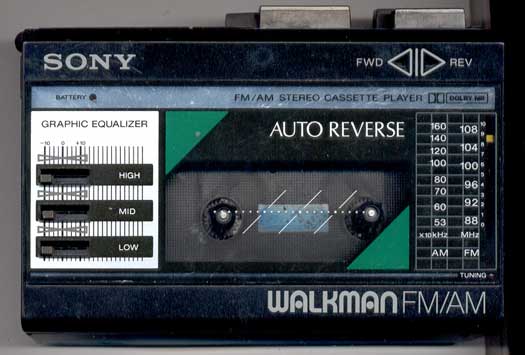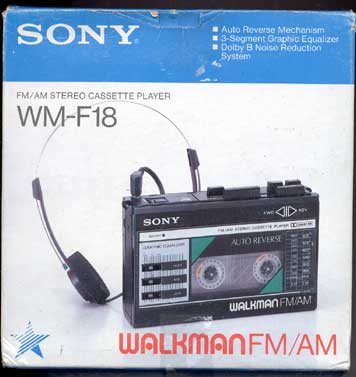Marantz Superscope. Few style points, but great quality from a leader in magnetic tape technology. AM/FM tuner, cassette recorder, “stereo matrix” (wide effect) through its 2-way, 4 speaker system. There were one-speaker mono predecessors, but this is the earliest we found to fit the configuration of what we now know as the boombox. Sold for over $200 in 1976.
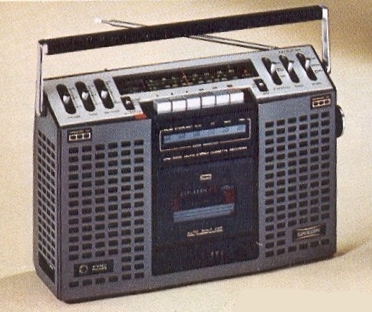
Monthly Archives: May 2002
1980s Sharp Top-Loading Boombox
One of the many sightings and brags discussed on our showd, this one was spotted by Paul in a downtown Miami electronics shop that had apparently paused in time–this thing looked brand spankin’ new, despited the fact that it was probably sold “new” back in 1985. Very cool system–features digital tuning, sleek pearl-white case, RCA-style inputs and outputs and a most unusual top-loading cassette drive.
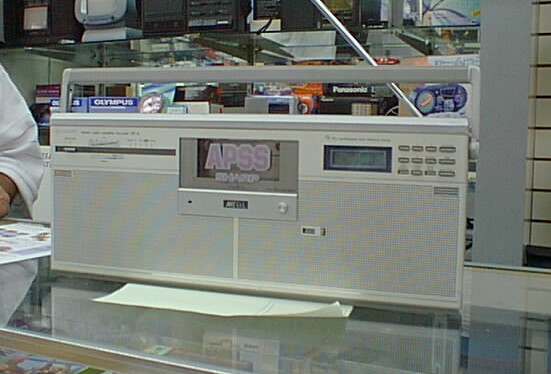
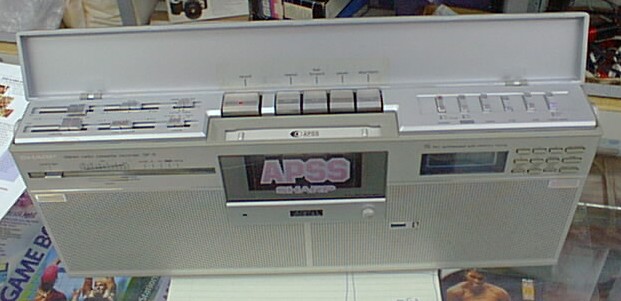
Toshiba Walkman Models
KT-4066
1986. Behold, the top of the line portable from Toshiba in ’86. Can you believe the features of this thing? Digital tuning, logic controls, Dolby, presets, auto-reverse, and a graphic eq. Unbelievable. No doubt there was some sticker shock for this back in ’86–we’re sure this model sold for at least $150 new back then. We’re willing to bet (and justify) one of these getting top dollar on Ebay today.
KT-S2
1981. Every collection has a “signature piece” and this may be it–Toshiba’s KT-S2. With the weight of a brick this model shows absolutely every sign of quality–from the metal chassis, to the ejecting well door, to the commanding tape control buttons. The KT-S2 offered separate left and right volume controls, normal/metal tape type swith, hi-lo tone switch, and radio/tape function switch. The requisite 4 penlight battery power only adds to the massiveness of the KT-S2. Take a closer look at the front. You’ll notice a yellow plastic button set within the chrome play button. That’s the “Hot Line” button, which mutes the portable’s audio, captures ambient noise via an internal microphone and sends it to the user’s headphones. The mystery is what the “T.L.” abbreviation stands for above the play button. The most unusual feature of the KT-S2 is the FM receiver. Yes, the KT-S2 offered an FM receiver and cassette playing capability way back in ’81. The radio portion is contained within a cassette-shaped component which fits into the cassette chamber. This device has its own model number, called the RP-S2. Even this little module has some cool features- an LED indicator for stereo and a mono-stereo switch. Here’s a pic of the front of the RP-S2, and here’s one of the back. Rumor has it that an AM module was also available in Japan. As far as we can tell, Toshiba was the first, but not the last to offer radio tuning within a removeable module like this one. *Update* Yep, the RP-A2 was Toshiba’s AM Tuner Pack that worked in both the KT-S2 and KT-S1.
KT-4016
1986. Boy, what a piece of crap. Sure, it looks innovative–the rewind and fast forward controls are unusually placed on the well door. Even more unusual is how these buttons operate–as you push them, they simply direct the flywheels down, which activate their movement. Sounds interesting, but I tried this out on one that I just purchased and when I opened the door, the mechanism literally flew out of the case into several pieces. I tried piecing it back together, but no luck. The cheap springs and plastic parts simply would not function as they were intended. No wonder why Toshiba dropped out of the portable market. It’s hard to believe this model was in the same line as the ultra-cool 4066. This model offered a battery LED indicator, a locking well door, and a normal/CrO2 & FM/FM stereo switch. Take a look below at Panasonic’s for a better implementation.
RP-2066
1986. Nice little headset unit offered by Toshiba during their walkman heyday. This one is powered by two AAA batteries, has a little whip antenna and features digital controls! The digital tuner is display in an analog fashion via an LCD bar indicator. Nice sound, too. Controls are smartly shaped so you can access them while wearing the headset. Audible beeps tell you when you’re tuning up the dial, or down or accessing one of the 5 presets. Here’s a pic of the entire unit.
KT-S1
1981. Sold around the same time as the KT-S2, the KT-S1 had a similar chassis, but featured a single volume slide control, and dual headphone jacks. This one also featured the FM radio cassette module. I was lucky enough to find one with the super rare RP-A2 AM cassette module!!
KT-4056
1986. Second to the KT-4066, the KT-4056 was almost the same, but lacked the Dolby NR feature. Very complicated looking stereo!
RP-S9
1986. Attractive little radio with the height and width of a credit card. This little AM/FM receiver has exceptional tuning! It has an unusual push lever power switch and is powered by two AAA batteries. It sold for around $40 back in its day. The little red velvet carrying case is a sweet compliment.
KT-4038
1988. As you can see, as we reach the latter half of the 80s, we depart from innovative and unusual walkman designs. This Toshiba lacks any unusual quality–it has a 3-band equalizer, AM/FM tuning, auto-reverse, typical functions and options for the period. Blah.
KT-R2
1981. Wow, this is a cool one. It’s Toshiba’s first recording portable stereo and even has a built-in stereo mic! Our fellow vintage electronics collector, Vassilios in Greece provided the pictures of this sleek model. Here’s a side-view pic. Finding such an old portable in this shape is indeed lucky! Thanks, Vassilios!
RP-2057
1987. One of the few portable stereos with digital tuning from the ’80s. Toshiba was one of the few companies who marketed this feature, and they did pretty well with it.
Aiwa Walkman Models
HS-J08
1985. What Walkman collection would be complete without an Aiwa portable stereo? This one looks so well-made, doesn’t it? AM/FM stereo tuner, recorder, carrying case too. Pretty boxy-looking, and the chrome is definitely a sweet touch. Check out that wired remote!!
HS-J350
1987. Aiwa is and was one of the big leaders in the portable stereo industry in the 80s, and remains one today. We can see why as we take at look at the HS-J350. This gem has recording capability, tuner and auto-reverse. Aiwa is reputed for their high-quality home stereo tape decks and that quality reached the portables too. Here’s a pic of the top of the unit. This was Jay’s workhouse back in the early ’90s and he retired it recently due to a loose headphone jack. Of course he’ll still keep it! *Update*: With renewed zeal in his Walkman collection, Jay pulled out his iron and soldered that loose connection–it’s working fine! We thank you for your letter and prayers through that tough time.
HS-T400
1984. Anyone have information on this one? The T400 offered Dolby NR (noise reduction), auto-reverse and an AM/FM tuner. We see a nice, bold tuning knob on the upper right. We’re guessing the unit was black and gray with chrome highlights like most around this period. Our friend K Wing recalls his HS-J07 performing faithfully during his college days, and it looked quite a bit like the T400.
HR-S01
1982. $50 in 1982 wouldn’t buy too much as far as portable stereos go, but you could grab one of these nice headsets from Aiwa–slim, nice reception of AM and FM and even an output jack! Best of all, the headset is capable of folding up to a nice small package. As far as we know, this was Aiwa’s first radio-only portable stereo.
HS-T700
1987. One of Aiwa’s top portable stereo cassette players. Amazing number of bells and whistles on this one–3 presets, auto-reverse, 4-band graphic equalizer, FM Stere/Mono switch, Dolby NR, a very slick LED radio position indicator, LEDs to indicate battery power and tape direction. Battery pack on the bottom hold two AAA batteries.
HS-J400
1984. Look familiar? It should, it’s the same chassis as the HS-T400, but with stero recording capability. Sold back in 1984 for around $135. Sleak, high performing, all Aiwa.
HS-J70
1985. A nice find by our friend K. Wing up in New Brunswick–this Aiwa stereo recorder sold for around $120 back in ’85 and offered all sorts of nice little options, including Dolby NR, auto-reverse and AM/FM tuning. I personally like the lock mechanism on the well door. We’re told that this model is very similar to the J07 also offered around this time, but the J70 lacked the music skip feature.
HS-J500
1985. Resembles the HS-J08, in fact it may be one in the same, differing only by model number. The chrome wired remote is slick, logic controls, hardshell case, dual headphone jacks and mini-whip antenna make this one of the desirable (and pricey) models from ’85.
HS-J300
1983. We consider ourselves lucky to have just the instruction manual for this one. Very cool and hi-tech for 1983, the HS-J300 offered good radio reception, due to its included telescopic whip antenna, stereo recording, FM Stereo indicator LED, auto-reverse and internal mic.
HS-P09
1986. Nothing particularly special about this one, but it small, solid and sounds great–all the reasons why Aiwa continues to be a leader in the portable stereo market.
We’re a little confused with the model number scheme used by Aiwa–we’ve gathered that the “T” after the hyphen indicates cassette player with tuner; a “J” indicated a recorder and a “P” means cassette player with no tuner. The “HS” and “HR” indicates the model is a personal stereo; the 3-digit models started in the mid-80s and continued well into the ’90s. We believe Aiwa distributed the same portables in Europe and North America, but under different model numbers.
Sony Walkman Models
TPS-L2
1979. Sony’s first portable stereo cassette player. The is the baby that started it all. It was a gradual hit in Japan in 1979, and released in the US a year later. The original version featured a well-crafted cassette player in a blue and silver chassis. A pleather pouch allowed the user to move about in freedom and wear the stereo on the hip. A second version sported the oh-so-familiar “walkman” logo in silver. The TPS-L2 featured a “Hot Line” button–the user presses a button to turn off the music and turn on a microphone to drive amplified ambient noise (like someone talking) through the headphones. This was a common feature during this era. Also shown is an ad from a 1981 catalog for the TPS-L2–notice there is no mention of the word “walkman!” Interstingly enough, the Walkman is a term that almost never was–Sony originally marketed this unit in the US as the Soundabout, wound up using the name already popularized in Japan. The Soundabout name was not forgotten, however. Sony used it for their AM-FM/portable cassette recorder a year or so later.
WM-1
1981. Another behemoth in the Walkman series. Not quite as neat as the original, but still a nice model. This model included a strap as well as a belt clip on the back (assumedly to market to both sexes), dual headphone jacks, LED battery indicator and recessed volume knob. Again, this model sold remarkably well, and the 80s began with every person below 20 wanting a personal, portable stereo. View close-up pictures of top, and side.
WM-2
1981. This one brought the portable cassette player market to a new level. The design is pretty amazing–the player is only slightly larger than the cassette itself. The chassis is metal, and check out those hi-tech buttons! Again, the Walkman rage was in full force at this time, so this model is fairly common.
WM-3
1981. The next generation of the WM-1. A little more bulky than the WM-2, but had all of the features of the previous years’ TPS-L2 and Walkman, including twin headphone jacks. Considered the Cadillac of portables at this time, as it was the most expensive but provided the nicest sound. This particular model is a little tough to find these days, perhaps because it was competing against its more affordable and smaller brother, the WM-2.
SRF-80W
1980. The SRF-30W was actually the first FM tuner in Sony’s Walkman line, but we’re attracted to the SRF-80W. Check out that oversized tuning knob–it makes for very accurate tuning. But the icing on the cake is undoubtedly its detachable boombox-style base!
WM-F5
1982. Portable stereo collectors would rank this as a worthy find, Sony’s premiere release in the insanely successful Sports Series. This is the only model in the Sports line we like, probably because it just screams 1982. It was sleak and functional, but the design nonetheless departed from the “traditional” black and silver boxy portable stereos of the day. The Sports line was built for joggers, cyclists, or any person outdoors and on the go. Joints contained gaskets and buttons were covered with rubber to resist shock and water, and the bright yellow color served to, um…irritate people?
WM-F2
1982. Another holy grail is the WM-F2, Sony’s first tuner/cassette recorder Walkman. This released upped the ante from the WM-2 by adding more functionality, but the same sleak all metal chassis sweetens the package. Incredibly sexy design even by today’s standards, we contend the F2’s look makes current day bubble-shaped portables look like cheap plasticky pigs.
WM-F30
1984. Sony pushes the envelope with even more functionality. Check out the WM-F30, complete with TV sound! Slightly chunky looking, but Sony was the first to complement VHF tv audio with AM and FM. Uncommon, but these still pop up on occasion at tag sales and flea markets.
WM-R2
1982. Sony’s first recording Walkman. Yes, another valuable model. Yes, we want one.
WM-F107
1983. Okay, there are two Sports models we like. This is the other, a solar-powered model. Unsure if it was ever available in the U.S.
SRF-30W
1981. Minimalist design is the trait that comes to mind with this model. This was the first tuner-only model in the Walkman line, and it’s probably the one that pops into the average person’s head when they hear the word “Walkman.” This makes sense, the SRF-30W was a big seller back in the early 80s–it was affordable, small and it performed well.
WM-F100
1989. The 10-year anniversary model. This was the smallest tuner-cassette Walkman to date, “design and production based on the concept of fantastic sound anytime, anywhere.”
WM-W800
1985. This has got to be the most unique and over-the-top Walkman ideas of all time–a portable stereo with dual cassette capability! One side plays, the other plays and records. Sold around 1985, the WM-W800 was priced at around $150. Here’s one of Sony’s press pictures.
WM-10
1983. Again, Sony sets the standard for what all portable stereos should be. Late in the year, Sony released the WM-10, the smallest, best-sounding cassette player ever. Only slightly larger than the cassette itself, this Walkman featured Dolby noise reduction and new engineering–specifically, an electronically controlled motor speed that resulted in stable sound and low “wow.” In 1983, this was on everyone’s Christmas list. The silver models seem to pop most frequently, but on occasion you may find one in gold.
WM-F1
1983. We puzzled with this one–we find no indication that this model was sold before the WM-F2. So why the lower model number? Perhaps in Japan this actually was released first. It’s not at all like the WM-F2, it’s larger, mostly plastic and lacks the futuristic looks. It did however sport dual headphone jacks, local/dx tuning switch and a hefty belt clip and strap. Sold for under $90 new.
WM-8
1984. Plain-jane cassette player. What’s with the maple leaf, eh?
WM-DD
198?. I don’t believe this particular model ever reached US shores. This Walkman demonstrates Sony’s departure from the belt-driven capstan mechanism, utilizing a “disc drive” capstan. The result is a more durable walkman with lower wow and flutter. This bright red beauty was found in Europe, where Sony apparently felt more comfortable marketing a wider variety of models in various colors. In America, the average ’80s Sony Walkman was black, silver or possibly a sporty yellow.
WM-F57
1986. What the…? For years, Sony marketed the Wakman as a personal stereo experience until this one. The WM-F57 was outfitted with a tiny speaker elmininating the need for headphones. This model shares the same chassis as the WM-F77, my favorite Sony Walkman of all time. It has auto-reverse, local/dx FM sensitivity switch.
WM-60
198?. We’ve got to thank our friend Jeroen Morrien of the Netherlands for bringing this terrific Walkman to our attention. This is clearly of 1985 or 1986 vintage, yet it’s equipped with two headphone jacks. How retro. The five-band eq was very much in vogue in the mid to late ’80s. Very sharp model and not a popular model. Great pic, thanks Jeroen!!
WM-F18
1985. My mom shelled out well over $80 to Caldor for this model. The chassis feels a little platicky, but it’s got everything you could want: auto- reverse, graphic eq, direction change and indicator, FM sensitivity and Dolby NR switch. I recently found another for $15, NOS (new old stock) still in the box. Who says you need Ebay to find these vintage gems? Here’s the box.
A Note on Sony Model Numbers: Stereo cassette players in the Walkman line originated with a “WM” followed by numbers and/or letters. The “F” in the model indicates the unit contains a tuner; and “R” indicates a recordable; absence of a letter after the dash indicates a cassette player model. The SRF line consists are tuner-only portables (SRF=Stereo Radio FM?)

